 |
||||||
|
The Burgenstrasse (Castle Road) was established in 1954 and runs from Mannheim to Prague, Czech Republic - almost 1,000 kilometers in length. There are more than 70 castles on the route. We stumbled upon this wonderfully interesting bit of riding and history when leaving Rothenburg - one of the towns on the Romantic Road. It turned out that Rothenburg is on both the Romantic Road and the Castle Road. So in May, 2002, we rode the westernmost section of the castle road from Rothenburg to Heidleberg. Like the Romantic Road, you need to pick and choose which locations to spend time at - if you try to do them all, you may never want to see a castle again.
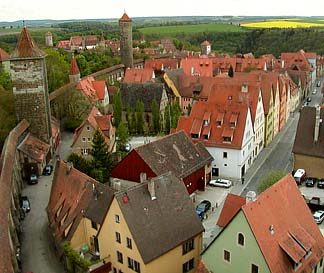 to get a fine perspective of the town from the top (right). At the left of the picture you can see a portion of the wall along with several towers to get a fine perspective of the town from the top (right). At the left of the picture you can see a portion of the wall along with several towers
A popular way to get around town is to take one of the many horse carriages (below). We found it interesting that these horses do not carry There are a couple of walking tours available, one in the early afternoon and another at night with the night watchman. We had hoped to join the nightwatchman’s tour, but as luck would have it, it started raining just before it started and we were not prepared. For the shoppers amongst you, Rothenburg is home to the Käthe Wohlfahrt shop, a huge Christmas shop open all year round. It goes on and on and on and appears to have just about any type of Christmas ornament you could want, as well as lots of fanciful displays. Just grab a basket as you enter, and enjoy the experience. This also appears to be home of the Schneeballen, available in every bakery in a variety of flavors. We are not sure, but they appear to be large balls of fried dough strips, covered in sugar, powdered sugar, chocolate or a number of other toppings. One of these days we’ll be brave and try one. When we returned in September 2002 with our friend Nancy, we got brave and tried a small one. It was so good we then bought 2 more large ones, one covered in chocolate and the other with cinnamon sugar. We all agreed the cinnamon-sugar was the best (the chocolate overpowered the dough). At one end of town, there is the Castle Garden area (where the castle originally stood; destroyed by an earthquake in 1356) with paths for strolling, just outside the Castle Gate. It also provides fantastic views of the surrounding area as well as the rest of Rothenburg. At right is the Castle Gate erected about 1360 and the guard houses toward the end of the 16th century. There is a mask in the fancy scroll work above the arch and hot From Rothenburg we headed west to Langenburg to find the palace of the Prince of Hohenlohe-Langenburg (the princely family still lives there today). This former castle was converted into a Renaissance mansion even before the Thirty Years War (1618-1648) and has changed little since that time. Tours are available, but we figured we would miss a lot since it was only given in German. Here there is also the motor museum belonging to the Prince, with more than 70 vehicle From here, the road continues southwest to Schwäbisch Hall, which has buildings dating back to t At the base of the stairs is the market place, a large open square where local producers bring their goods on market day. Opposite St. Michael’s is the town hall (left), an imposing Baroque building (1735) that took 10 years to completely restore after being burned Waldenburg was our next stop and where we decided to spend a few quiet days. The town is a “don’t blink” town, only a couple of blocks long, but has several sights of interest as well as a handful of hotels. We had a nice view of the
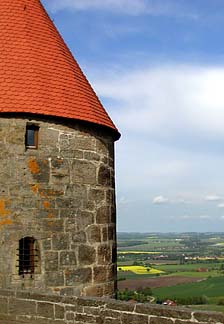 Staufer tower on the right. The tower is part of the medieval fortification of the old town Staufer tower on the right. The tower is part of the medieval fortification of the old town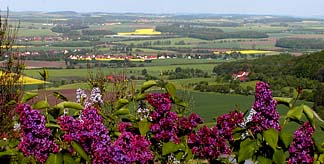 along with the night watch tower (left, below), looking out over the Hohenlohe plain below. along with the night watch tower (left, below), looking out over the Hohenlohe plain below.
At right is a view of the expansive plain, complete with the bright yellow fields of rape in bloom. In Waldenburg there is a fine example of sgraffito on The castle in Waldenburg houses a heraldic seal museum (not open while we were there) as well as several local businesses. You can walk around the outside and into the center courtyard, but that’s about all you will see of it. There are also plenty of walking trails on the hill and down into the t Down on the plain below, we soon came upon the town of Neuenstein with its castle near the center of town. This castle now houses the Hohenlohe museum, but was unfortunately closed on Mondays. We got close enough for a quick look from the outside, but not much more. One of the many towers is shown at left, peeking through the many surrounding trees. Our next stop was the Guttenberg castle (not pictured) near Burg Guttenberg, set high upon the hill above the Neckar River. This castle has
The Hauptstrasse is the main pedestrian street in Heidelberg and one can spend hours here, wandering among the shops, stopping for a bite in one of the many restaurants, or buying an ice cream cone to enjoy on your stroll. Because of tightly-packed buildings in Heidelberg, finding a place to park the motorcycles was difficult. Most hotels offer a special parking rate at one of the public garages a few blocks away. However, we were able to find a nice room at the Hotel Zum Pfalzgrafen (Kettengasse 21) and Frau Schneider was kind enough to let us park the bikes in her small courtyard. She was very accommodating and took good care of us while we were there. From Heidelberg, it is just a short journey to Mannheim, the westernmost end of the Castle Road. We took the train from Heidelberg to Mannheim which was quite convenient (12 minutes for the express, 20 minutes for the slow train).
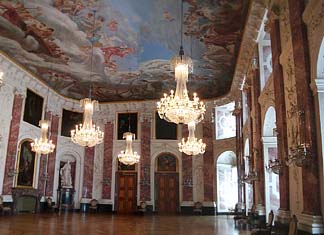 d by the local university, but you can visit the Knights Hall and a couple of lesser rooms. At left is a photo of the Knight’s Hall with its spectacular ceiling fresco and impressive parquet inlayed floor, not to mention the beautiful marble columns and intricate plaster work on the walls. d by the local university, but you can visit the Knights Hall and a couple of lesser rooms. At left is a photo of the Knight’s Hall with its spectacular ceiling fresco and impressive parquet inlayed floor, not to mention the beautiful marble columns and intricate plaster work on the walls.
And that concluded this portion of the Castle Road. Overall, we found the “road” to be an interesting way to see many of Germany’s smaller towns (as well as some of the larger ones) and to take a glimpse of its historic past. For the most part, this section of the Castle Road takes the visitor on secondary roads one would not normally find. We find this enjoyable as the roads have less traffic and are usually more scenic. They also lead the adventurer into the smaller towns and villages the normal tourist misses. However, a word of caution: there are many signposts along the way to guide the traveler, but some appear to be missing (or maybe we just missed them!). At any rate, it is sometimes difficult to follow exactly. Also, once you get to a town, the location of the castle is not always obvious and in the larger towns this can be a bit frustrating. We had purchased a booklet (“The Castles Route”) that had a general map, but it was not very specific. So be ready for an adventure (isn’t that what it is all about?). |
||||||
|
If you find typographical errors or have any other problems when looking at the site please contact the Webmaster describing the problem and the page involved. |
||||||
|
Copyright © 2000-2009 Jim Seavey and Verna Norris All Rights Reserved |
||||||

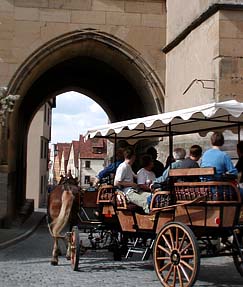 the “poop bags” we normally see, but the driver stops each time the horse dumps and cleans it up. You don’t suppose the horses have figured out this is how to get a rest, do you?
the “poop bags” we normally see, but the driver stops each time the horse dumps and cleans it up. You don’t suppose the horses have figured out this is how to get a rest, do you?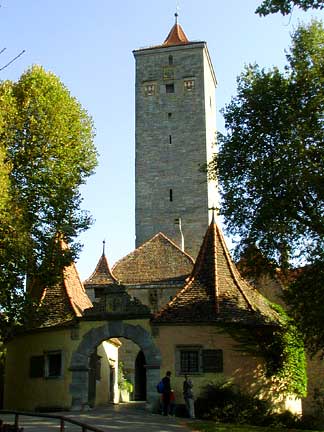
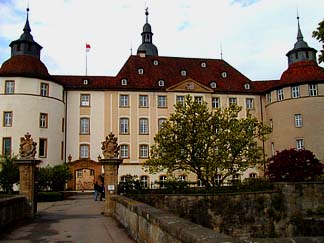 oil would be poured through the mouth hole onto attackers below.
oil would be poured through the mouth hole onto attackers below. 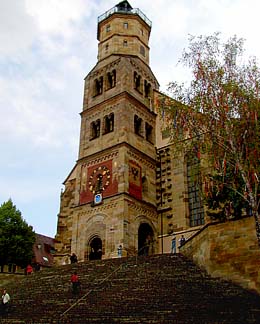 s covering 100 years of motoring history.
s covering 100 years of motoring history. 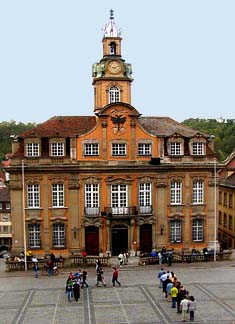 he 12th century. At right is the p ar is h c h ur c h of St. M ic h ae l (1 2t h century), with the front steps that are a symbol of this town. There are 54 steps, up to 70 meters wide that lead up to the church and also serve as the stage for open-air plays presented every year from June to August.
he 12th century. At right is the p ar is h c h ur c h of St. M ic h ae l (1 2t h century), with the front steps that are a symbol of this town. There are 54 steps, up to 70 meters wide that lead up to the church and also serve as the stage for open-air plays presented every year from June to August. 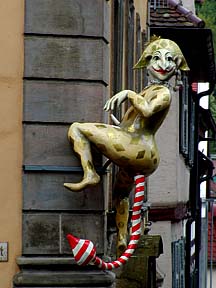 out in 1945. In the foreground of the picture you can see a portion of the market square where the locals were practicing a formation dance to the drum and fifes playing on the steps.
out in 1945. In the foreground of the picture you can see a portion of the market square where the locals were practicing a formation dance to the drum and fifes playing on the steps.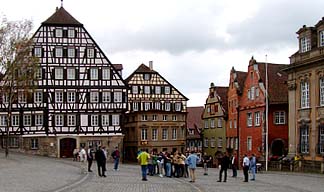 At left is a view of some of the many half-timbered houses off the square, the one at the left of the picture being one of the largest we have seen. And at right, one of the local jokers, just “hanging” around having a good time.
At left is a view of some of the many half-timbered houses off the square, the one at the left of the picture being one of the largest we have seen. And at right, one of the local jokers, just “hanging” around having a good time.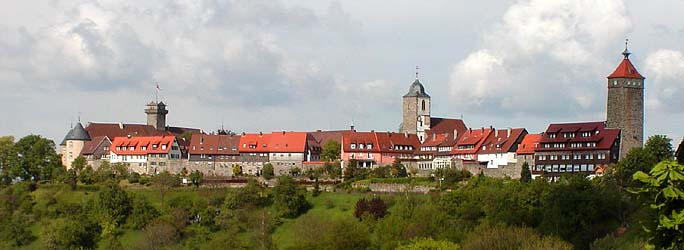
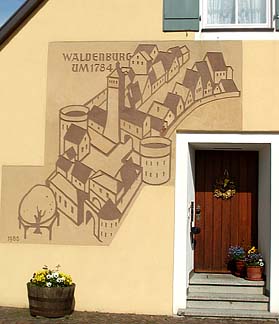 one of the houses. This type of decoration involves scratching a design into the wall plaster, giving a 3D effect. This one also has the indented portions painted, to highlight the effect. The design itself is a stylized view of the city of Waldenburg as it might have looked around 1784. The town is built on a narrow spit of land high above the plain below, so very little in the way of fortification was actually needed.
one of the houses. This type of decoration involves scratching a design into the wall plaster, giving a 3D effect. This one also has the indented portions painted, to highlight the effect. The design itself is a stylized view of the city of Waldenburg as it might have looked around 1784. The town is built on a narrow spit of land high above the plain below, so very little in the way of fortification was actually needed.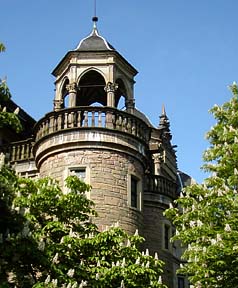 owns below.
owns below.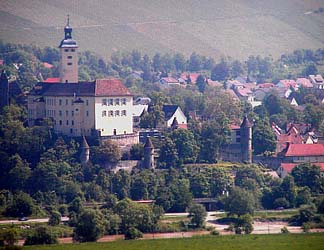 a museum explaining the history of the castle as well as a center for birds of prey, including daily demonstrations with eagles and vultures (only in German while we were there). Across the river from Bad Guttenberg lies the Horneck Castle (right) in the town of Gundelsheim, originally built in 1420 and burned during the Peasants’ Revolt in 1525, then rebuilt shortly afterwards. Today it houses an old people’s home and museum.
a museum explaining the history of the castle as well as a center for birds of prey, including daily demonstrations with eagles and vultures (only in German while we were there). Across the river from Bad Guttenberg lies the Horneck Castle (right) in the town of Gundelsheim, originally built in 1420 and burned during the Peasants’ Revolt in 1525, then rebuilt shortly afterwards. Today it houses an old people’s home and museum.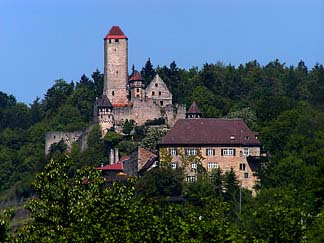 Following along the Neckar River a bit further, you will find several castles hanging on high points overlooking the river. Hornberg Castle (left) overlooks the town of Neckarzimmern and sits high on the hill among the dense woods. Hornberg Castle is the oldest castle in the Neckar Valley and was once he home of a famous knight-at-arms, Götz von Berlichingen, the hero of the play that brought fame to the young Goethe. Gotz bought the castle in 1517, but then had to spend 12 years inside it under house arrest after he had led a horde of rebellious peasants in 1525. Today the castle walls house a hotel and restaurant. There is also a small museum inside the castle that even contains the suit of armour worn by the famous warrior.
Following along the Neckar River a bit further, you will find several castles hanging on high points overlooking the river. Hornberg Castle (left) overlooks the town of Neckarzimmern and sits high on the hill among the dense woods. Hornberg Castle is the oldest castle in the Neckar Valley and was once he home of a famous knight-at-arms, Götz von Berlichingen, the hero of the play that brought fame to the young Goethe. Gotz bought the castle in 1517, but then had to spend 12 years inside it under house arrest after he had led a horde of rebellious peasants in 1525. Today the castle walls house a hotel and restaurant. There is also a small museum inside the castle that even contains the suit of armour worn by the famous warrior. Our next stop was
Our next stop was 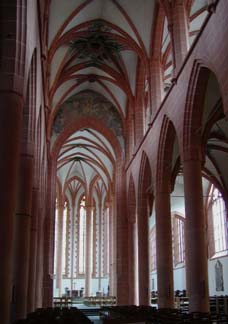 e 1600’s. The rebuilt castle suffered further ruination in 1764 when it was struck by lightening. Today, the castle ruins are one of the most visited sights in Germany. The photo at right shows the view of the castle ruins high above the town of Heidelberg, which sits along the Neckar River.
e 1600’s. The rebuilt castle suffered further ruination in 1764 when it was struck by lightening. Today, the castle ruins are one of the most visited sights in Germany. The photo at right shows the view of the castle ruins high above the town of Heidelberg, which sits along the Neckar River. 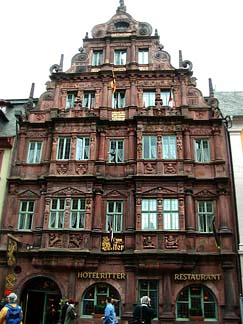 The town of Heidelberg is quite interesting for the visitor as there are several sights to be visited. Of the several interesting churches in the town, the Church of the Holy Ghost (begun in 1398; pictured at left) is most prominent and for only 50 Euro cents you can climb the 204 steps up the tower to get a commanding view of the city in all directions. Across from the church is the Hotel Ritter, one of the few houses in Heidelberg to survive the demolitions during the Wars of Succession. It was erected in 1592 and is considered to be one of the most impressive monuments of the late Renaissance period.
The town of Heidelberg is quite interesting for the visitor as there are several sights to be visited. Of the several interesting churches in the town, the Church of the Holy Ghost (begun in 1398; pictured at left) is most prominent and for only 50 Euro cents you can climb the 204 steps up the tower to get a commanding view of the city in all directions. Across from the church is the Hotel Ritter, one of the few houses in Heidelberg to survive the demolitions during the Wars of Succession. It was erected in 1592 and is considered to be one of the most impressive monuments of the late Renaissance period.
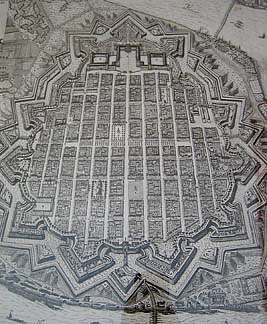 The palace faces onto the old town of Mannheim which has an unusual layout, especially for its time. The town was planned in a grid pattern, and rather than street names, the blocks of buildings were numbered from A1 to U15. The picture at right shows the town as it was originally laid out, complete with town walls (which no longer exist). The castle is the large U-shaped building at the top of the picture. The central street is now pedestrianized (except for the trams). Near the center of the old town is the market square and several of the streets surrounding it are for pedestrians only. This makes for a lovely stroll and there are lots of interesting stores and shops to investigate along the way.
The palace faces onto the old town of Mannheim which has an unusual layout, especially for its time. The town was planned in a grid pattern, and rather than street names, the blocks of buildings were numbered from A1 to U15. The picture at right shows the town as it was originally laid out, complete with town walls (which no longer exist). The castle is the large U-shaped building at the top of the picture. The central street is now pedestrianized (except for the trams). Near the center of the old town is the market square and several of the streets surrounding it are for pedestrians only. This makes for a lovely stroll and there are lots of interesting stores and shops to investigate along the way.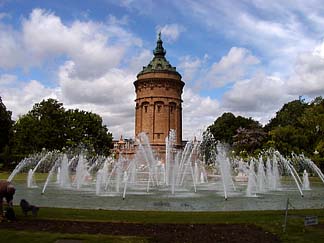 Another interesting sight in Mannheim is the Wasserturm (water tower; built from 1886-1889), pictured at left. This is a 60 meter high water reservoir which is crowned by the statue of the Greek god Amphitrite. The water tower has huge fountains on either side and is now situated in a park-like setting. A great place to stroll or to just sit and relax.
Another interesting sight in Mannheim is the Wasserturm (water tower; built from 1886-1889), pictured at left. This is a 60 meter high water reservoir which is crowned by the statue of the Greek god Amphitrite. The water tower has huge fountains on either side and is now situated in a park-like setting. A great place to stroll or to just sit and relax.